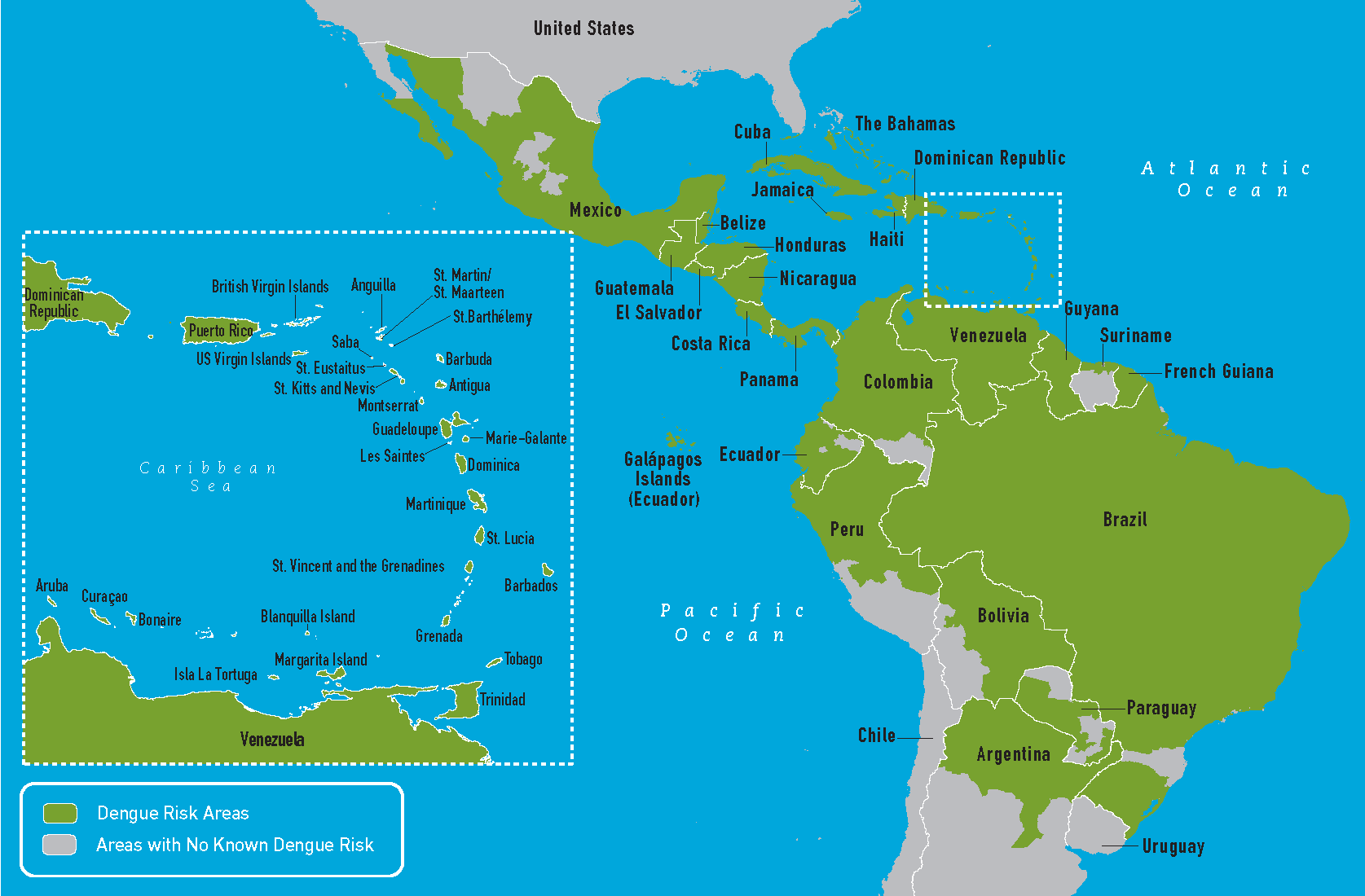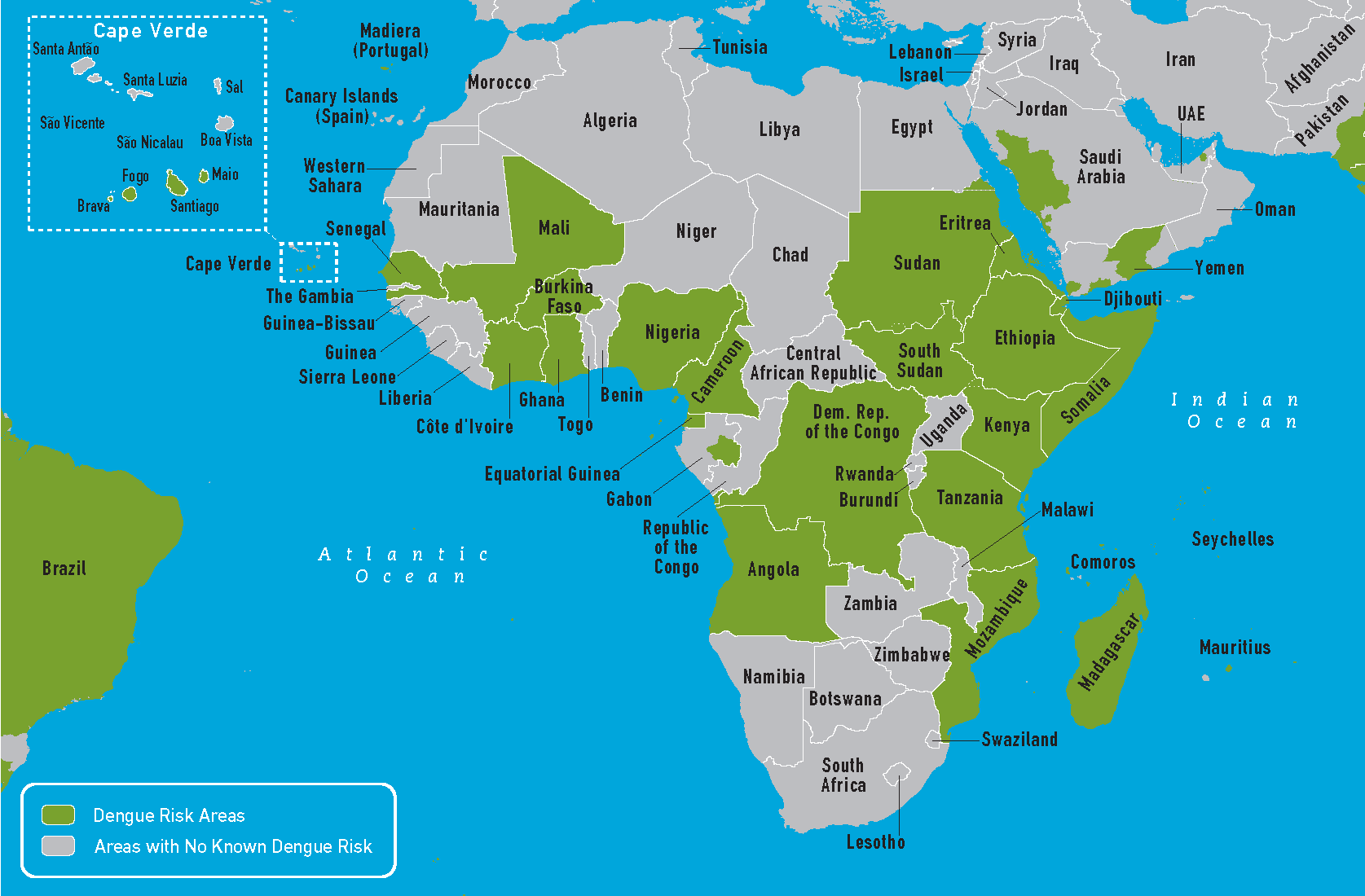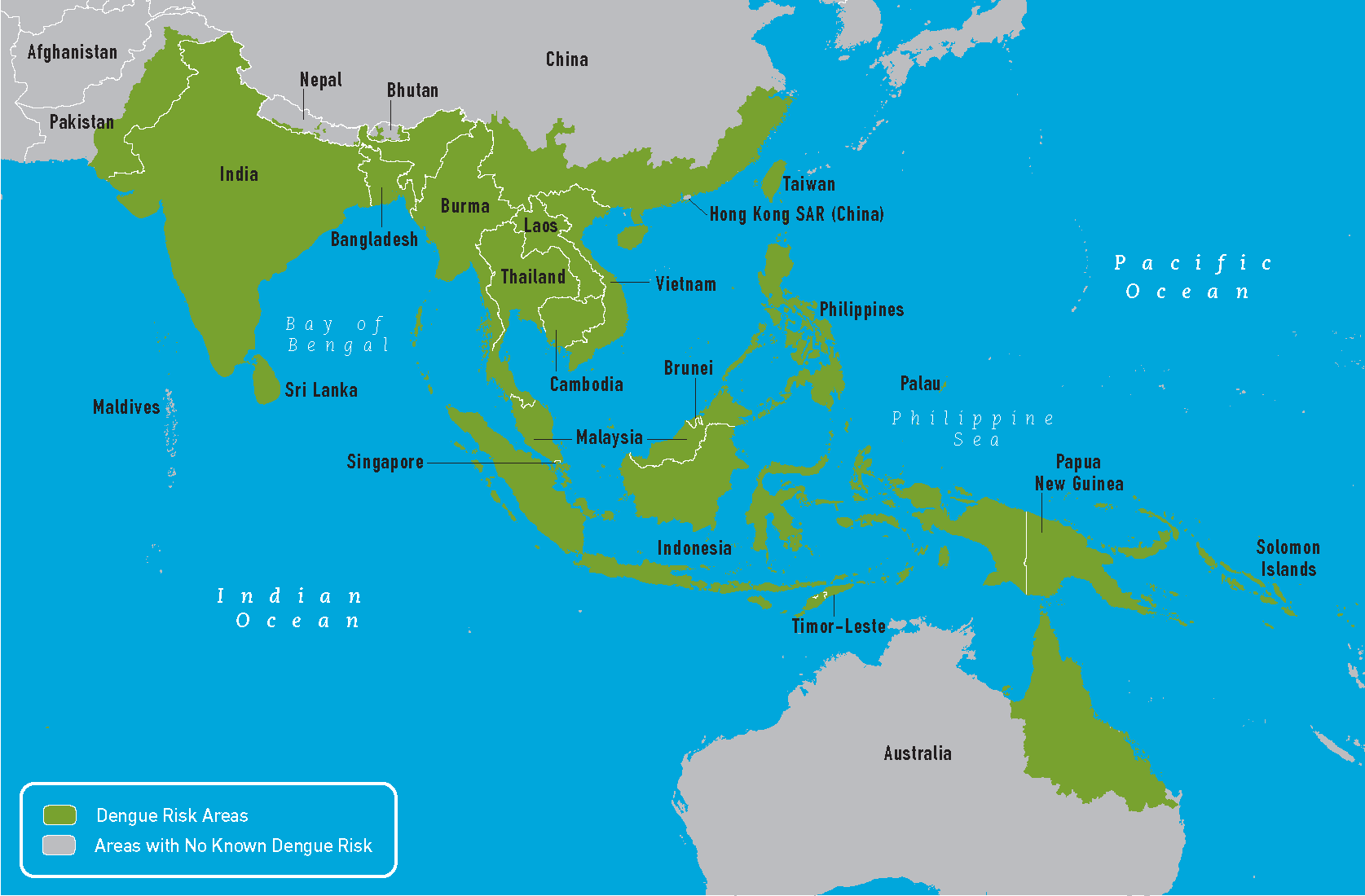Dengue fever epidemiology and demographics
|
Dengue Fever Microchapters |
|
Diagnosis |
|---|
|
Treatment |
|
Case Studies |
|
Dengue fever epidemiology and demographics On the Web |
|
American Roentgen Ray Society Images of Dengue fever epidemiology and demographics |
|
Risk calculators and risk factors for Dengue fever epidemiology and demographics |
Editor-In-Chief: C. Michael Gibson, M.S., M.D. [2]
Overview
Dengue is endemic throughout the tropics and subtropics and is a leading cause of febrile illness among travelers returning from the Caribbean, South America, and South and Southeast Asia, according to an analysis of data collected by the GeoSentinel Surveillance Network. Dengue occurs in more than 100 countries worldwide, including Puerto Rico, the US Virgin Islands, and US-affiliated Pacific Islands. Sporadic outbreaks with local transmission have occurred in Florida, Hawaii, and along the Texas-Mexico border. There are 40 million cases worldwide each year.
Epidemiology and Demographics
 |
 |
 |
The first epidemics occurred almost simultaneously in Asia, Africa, and North America in the 1780s. The disease was identified and named in 1779. A global pandemic began in Southeast Asia in the 1950s and by 1975 DHF had become a leading cause of death among children in many countries in that region. Epidemic dengue has become more common since the 1980s - by the late 1990s, dengue was the most important mosquito-borne disease affecting humans after malaria, there being around 40 million cases of dengue fever and several hundred thousand cases of dengue hemorrhagic fever each year. There was a serious outbreak in Rio de Janeiro in February, 2002 affecting around one million people and killing sixteen.
Significant outbreaks of dengue fever tend to occur every five or six years. There tend to remain large numbers of susceptible people in the population despite previous outbreaks because there are four different strains of the dengue virus and because of new susceptible individuals entering the target population, either through childbirth or immigration.
There is significant evidence, originally suggested by S.B. Halstead in the 1970s, that dengue hemorrhagic fever is more likely to occur in patients who have secondary infections by serotypes different from the primary infection. One model to explain this process is known as antibody-dependent enhancement (ADE), which allows for increased uptake and virion replication during a secondary infection with a different strain. Through an immunological phenomena, known as original antigenic sin, the immune system is not able to adequately respond to the stronger infection, and the secondary infection becomes far more serious.[1] This process is also known as superinfection (Nowak and May 1994; Levin and Pimentel 1981).
In Singapore, there are about 4,000-5,000 reported cases of dengue fever or dengue haemorrhagic fever every year. In the year 2003, there were 6 deaths from dengue shock syndrome. It is believed that the reported cases of dengue are an underrepresentation of all the cases of dengue as it would ignore subclinical cases and cases where the patient did not present for medical treatment. With proper medical treatment, the mortality rate for dengue can therefore be brought down to less than 1 in 1000.
Developed Countries
United States
Nearly all dengue cases reported in the 48 continental states were acquired elsewhere by travelers or immigrants. (Travel Associated Dengue Infections - United States, 2001- 2004 , Imported Dengue - United States, 1999 and 2000 ) Because contact between Aedes and people is infrequent in the continental U.S., these imported cases rarely result in secondary transmission. The last reported continental dengue outbreak was in south Texas in 2005. (Dengue Hemorrhagic Fever - U.S.- Mexico Border, 2005) A small dengue outbreak occurred in Hawaii in 2001.
Most dengue cases in U.S. citizens occur in those inhabitants of Puerto Rico, the U.S. Virgin Islands, Samoa and Guam, which are endemic for the virus. Dengue and DHF have been a particular challenge in Puerto Rico, where outbreaks have been reported since 1915 and large island-wide epidemics have been documented since the late 1960s. The most recent island-wide epidemic occurred in 2007, when more than 10,000 cases were diagnosed. In Puerto Rico, and most of the Caribbean Basin, the principle dengue vector Ae. aegypti is abundant year-round. Dengue transmission in the Puerto Rico follows a seasonal pattern. Low transmission season begins in March and lasts until June, and high transmission begins in August until November.
Asia Pacific
- Australia: 2006 March 15, 2 confirmed cases at Gordonvale, Cairns, Queensland.
- China: September 2006, 70 cases since June in Guangzhou,Guangdong.[2]
- Cook Islands: [3](October 2006-January 2007) 460 cases.
- Singapore: 2007 more than 4029 cases, 8 deaths at 29 Sept.. 2005 at least 13 deaths. 2004 9460 cases. 2003, 4788 cases.
Developing Countries
Americas
- Dominican Republic: [4](August – October 2006) 4,968 cases with 44 dead.
- Puerto Rico: [5](August 2007) 2,343 confirmed cases of dengue.
- Cuba: Media reports [6][7][8][9] (dated September and October 2006) speculate on an outbreak although there is no official report.
Asia Pacific
- India: 2006 September, more than 400 cases and 22 deaths were reported due to dengue fever in New Delhi. [10] By October 7, 2006, reports were of 3,331 cases of the mosquito-borne virus and a death toll of 49. [11]
- Indonesia: 2004 80,000 infected with 800 deaths.
- Malaysia: January 2005 33,203 cases.
- Pakistan: 2006 Over 3230 cases, 50 deaths.
- Karachi 2006 October, the number of infected patients rose to 1836 of which 30 had died.
- Lahore, 2006 October 23, the disease shifted to Lahore during the holidays with the luggage of some people travelling to their homes to celebrate Eid. The number of infected patients is 400 by October 31, of which 4 had died.
- Philippines: [12](January - August 2006) 13,468 cases with 167 dead.
- Thailand: 2005 May, 7200 infected. At least 12 dead.
Outbreaks
| Country | Cases | Deaths | Date of Information | Sources |
|---|---|---|---|---|
| Cambodia | 20,000 | 38 | Sep. | [3] |
| Costa Rica | 19,000 | 1 | 7 Sep. | [4] |
| India, (West Bengal) | 90,000 | 1,500 | Sep. | [5] |
| Indonesia | 80,837 | 1,099 | Jan. 2006 | [6] |
| Malaysia | 32,950 | 83 | 1 Nov. | [7] |
| Martinique | 6,000 | 2 | 26 Sep. | [8] |
| Philippines | 21,537 | 280 | 2 Oct. | [9] |
| Singapore | 12,700 | 19 | 22 Oct. | [10] |
| Sri Lanka | 3,000 | - | 16 Sep. | [11] |
| Thailand | 31,000 | 58 | Sep. | [12] |
| Vietnam | 20,000 | 28 | 4 Oct. | [13] |
| Pakistan | 4,800 | 50 | 11 Dec 2006. | [14] |
| Total† | 232,724 | 16,673 | — | — |
| †For listed countries only. World Health Organization estimates that there may be 50 million cases of dengue infection worldwide each year. [15] | ||||
Twenty-four US cases of dengue were reported in 2014 among individuals with travel history to a dengue endemic country in the two weeks prior to onset. Countries of origin were: Bolivia, Brazil (2), Caribbean, Cuba (8), Dominican Republic (4), Guadeloupe, Honduras, Puerto Rico (3), Trinidad, and Venezuela (2). Counties reporting cases were: Alachua, Broward (2), Clay, Hillsborough (3), Marion, Miami-Dade (10), Orange, Osceola (3), Pinellas, and Seminole. Four of the cases were reported in non-Florida residents.[13]
During the first months of 2007 over 16,000 cases have been reported in Paraguay, of which around 100 have been detected as DHF cases. This new epidemic is expected to continue in Paraguay for several months, given the forecast of continuous rain all through the summer. Ten deaths have also been reported, including recently a high ranking member of the Ministry of Health. The epidemic has been the root of a scandal in the Paraguayan Department of Health, where one official has resigned because he had approved the use of expired batches of insecticide to control the mosquito vectors of dengue.[14][15] The disease has propagated to Argentina (where it is not considered endemic), in almost all cases by people who recently arrived from Paraguay.In the Brazilian state of Mato Grosso do Sul, which borders on Paraguay, the number of cases in March 2007 is estimated to be more than 45,000.[15] Epidemics in the states of Ceará, Pará, São Paulo, and Rio de Janeiro have taken the Brazilian national tally of cases this year to over 70,000, with upwards of 20 deaths. The proportion of cases registered as DHF is reported to be higher than in previous years.
External Links
- DengueMap: An interactive map of global dengue activity collaboratively developed by CDC and HealthMap.org
References
- ↑ Rothman, Alan L. Dengue: defining protective versus pathologic immunity. (Full text-html) J Clin Invest. 2004 April 1; 113(7): 946–951
- ↑ China, Dengue Fever Cases Jump, Taipei Times, 29 August, 2006.
- ↑ "460 people in Cook Islands affected by Dengue Fever outbreak". Radio New Zealand International. 15 January, 2007. Retrieved 2007-01-15. Check date values in:
|date=(help) - ↑ Batista, L. "Más de 4,968 afectados por dengue" (in Spanish). Diario Libre. Retrieved 2006-10-19. Unknown parameter
|coauthors=ignored (help) - ↑ "Dengue fever surging in Puerto Rico". MSNBC, Telemundo. Aug. 08, 2007. Retrieved 2007-26-09. Check date values in:
|accessdate=, |date=(help) - ↑ "Protecting the Revolution". Strategypage.com. September 17, 2006. Retrieved 2006-10-07.
- ↑ Acosta, Dalia (2006-09-12). "War on Mosquitoes Continues During Global Summit". Inter Press Service. Retrieved 2006-10-07.
- ↑ "Cuba wages war on tiny enemy". Independent Online, South Africa. September 25, 2006. Retrieved 2006-10-07.
- ↑ "Cuba waging war against dengue fever". Miami Herald. October 7, 2006. Retrieved 2006-10-07.
- ↑ http://www.iht.com/articles/ap/2006/10/02/asia/AS_GEN_India_Dengue_Outbreak.php International Herald Tribune, Associated Press News, Published: October 2, 2006 & Accessed on: October 2, 2006]
- ↑ India says dengue outbreak serious as death toll rises Pratap Chakravarty, news.yahoo.com, 7 October 2006. Retrieved 8 October 2006.
- ↑ Santos, Tina (September 10, 2006). "DOH names dengue-hit areas in metropolis". Philippine Daily Inquirer. Retrieved 2006-10-07.
- ↑ [1]
- ↑ "Dengue sparks Paraguay emergency". BBC News. 2 March 2007. Retrieved 2007-06-19.
- ↑ 15.0 15.1 "Paraguay dengue official sacked". BBC News. 6 March 2007. Retrieved 2007-06-19.